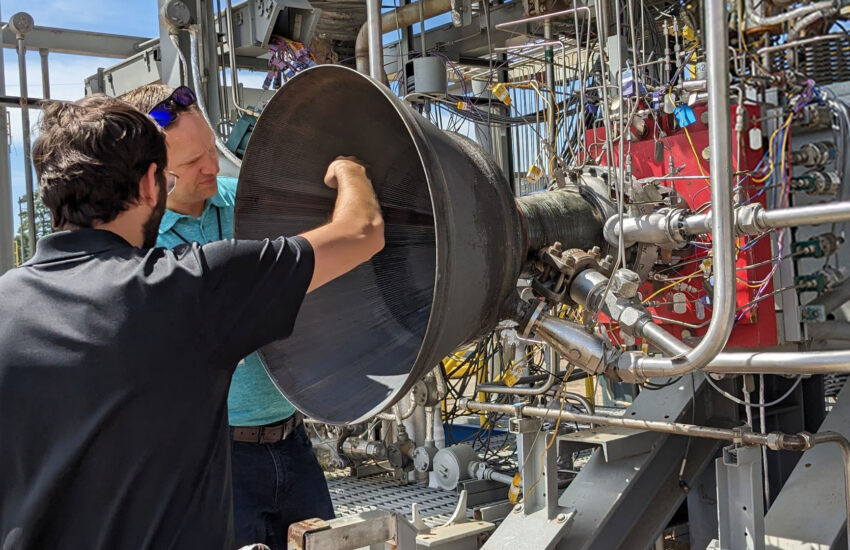The widespread commercial adoption of additive manufacturing technologies, commonly known as 3D printing, is no surprise to design engineers at NASA’s Marshall Space Flight Center in Huntsville, Alabama whose research created stronger, lighter weight materials and new manufacturing processes to make rocket parts.
NASA’s RAMPT (Rapid Analysis and Manufacturing Propulsion Technology) project is on the cutting-edge of additive manufacturing – helping the agency and industry produce new alloys and additively manufactured parts, commonly referred to as 3D printing, according to Paul Gradl, the project’s co-principal investigator at NASA Marshall.
“Across NASA’s storied legacy of vehicle and hardware design, testing, and integration, our underlying strength is in our application of extremely durable and severe environment materials and innovative manufacturing for component design,” said Gradl. “We strive to fully understand the microstructure and properties of every material and how they will ultimately be used in components before we make them available to industry for flight applications.”
The same principle applies to additive manufacturing, the meticulous process of building components and hardware one layer of material at a time.
“The RAMPT project’s goal is to support commercial, technical readiness, enabling our industry partners to meet the challenges inherent in building new generations of safer, more cost-effective deep space exploration propulsion systems,” said John Fikes, RAMPT project manager.
Since its inception, RAMPT has conducted 500 test-firings of 3D-printed injectors, nozzles, and chamber hardware totaling more than 16,000 seconds, using newly developed extreme-environment alloys, large-scale additive manufacturing processes, and advanced composite technology. The project has also started developing a full-scale version for the workhorse RS-25 engine – which experts say could reduce its costs by up to 70% and cut manufacturing time in half.
As printed structures are getting bigger and more complex, a major area of interest is the additive manufacturing print scale. A decade ago, most 3D-printed parts were no bigger than a shoebox. Today, additive manufacturing researchers are helping the industry produce lighter, more robust, intricately designed rocket engine components 10-feet tall and eight-feet in diameter.
“NASA, through public-private partnerships, is making these breakthroughs accessible to the commercial space industry to help them rapidly advance new flight technologies of their own,” Gradl said. “We’re solving technical challenges, creating new supply chains for parts and materials, and increasing the industry’s capacity to rapidly deliver reliable hardware that draws a busy commercial space infrastructure ever closer.”
The RAMPT project does not just develop the end technology but the means to fully understand that technology, whatever the application. That means advancing cutting-edge simulation tools that can identify the viability of new alloys and composites at the microstructural level – assessing how they handle the fiery rigors of liftoff, the punishing cold of space, and the dynamic stresses associated with liftoffs, landings, and the long transits between.
NASA’s strategy to encourage commercial and academic buy-in is to offer public-private partnership opportunities, wherein industry and academia contribute as much as 25% of project development costs, allowing them to reap the benefits.
For example, NASA successfully delivered a refined version of an alloy, known as GRCop42, created at NASA Glenn nearly 40 years ago which helped commercial launch provider, Relativity Space, launch the first fully 3D-printed rocket in March 2023.
“Our primary goal with these higher-performance alloys is to prove them in a rocket engine test-fire environment and then hand them off to enable commercial providers to build hardware, fly launch vehicles, and foster a thriving space infrastructure with real scientific, social, and economic rewards,” Gradl said.
A key benefit of additive manufacturing hardware development is radically reducing the “design-fail-fix” cycle – when engineers develop new hardware, ground-test it to failure to determine the hardware’s design limits under all possible conditions and then tweak accordingly. That capability is increasingly important with the creation of new alloys and designs, new processing techniques, and the introduction of composite overwraps and other innovations.
The RAMPT project did just that, successfully advancing new additive manufacturing alloys and processes, integrating them with carbon-fiber composites to reduce weight by up to 40%, developing and validating new simulation tools – and making all this data available to industry through public-private partnerships.
“We’re able to deliver prototypes in weeks instead of years, conduct dozens of scaled ground tests in a period that would feasibly permit just one or two such tests of conventionally manufactured hardware, and most importantly, deliver technology solutions that are safer, lighter, and less costly than traditional components,” Gradl said.
Fikes added, “Ten years from now, we may be building rocket engines – or rockets themselves – out of entirely new materials, employing all-new processing and fabrication techniques. NASA is central to all of that.”
The RAMPT project continues to progress and receive recognition from NASA and industry partners. On July 31, the RAMPT team was awarded NASA’s 2024 Invention of The Year award for its excellence and contributions to NASA and the commercial industry’s deep space exploration goals.
NASA’s Marshall Spaceflight Center in Huntsville, Alabama, leads RAMPT, with key support among engineers and technologists at NASA’s Glenn Research Center in Cleveland; Ames Research Center in Mountain View, California; Langley Research Center in Hampton, Virginia; and Auburn University in Auburn, Alabama, plus contributions from other academic partners and industry contractors. RAMPT is funded by NASA’s Game Changing Development Program within the agency’s Space Technology Mission Directorate.
Learn more at:
https://www.nasa.gov/rapid-analysis-and-manufacturing-propulsion-technology
Ramon J. Osorio
Marshall Space Flight Center, Huntsville, Alabama
256-544-0034
ramon.j.osorio@nasa.gov

